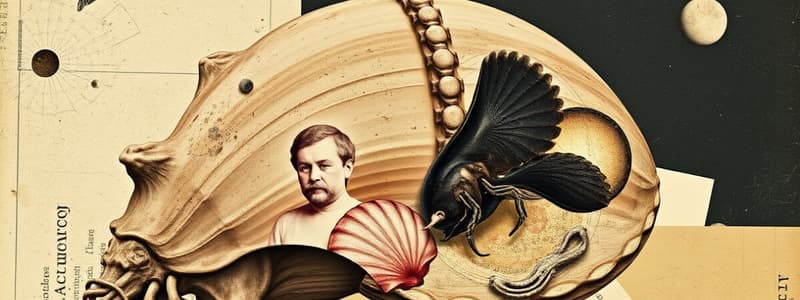Podcast
Questions and Answers
What does 'Scaphopoda' mean?
What does 'Scaphopoda' mean?
- sword foot
- spade foot (correct)
- open shell
- flat shell
What are the two main characteristics of Scaphopoda?
What are the two main characteristics of Scaphopoda?
Tusk-shaped conical shell, open at both ends and anterior threadlike adhesive feeding tentacles called captacula.
Scaphopoda lack _____, heart/circulatory system, and osphradium.
Scaphopoda lack _____, heart/circulatory system, and osphradium.
ctenidia
Where are Scaphopoda typically found?
Where are Scaphopoda typically found?
How do Scaphopoda feed?
How do Scaphopoda feed?
Scaphopoda reproduce with external fertilization.
Scaphopoda reproduce with external fertilization.
To which groups do molecular data suggest Scaphopoda are closest?
To which groups do molecular data suggest Scaphopoda are closest?
Flashcards are hidden until you start studying
Study Notes
Scaphopoda Overview
- "Scaphopoda" translates to "spade foot" in reference to their shell shape.
- This class includes around 300-400 species, ranging in size from 2mm to 15cm.
Characteristics
- Possess a tusk-shaped conical shell that is open at both ends.
- Feature anterior, threadlike, adhesive feeding tentacles known as captacula.
Body Plan
- Display a typical molluscan structure but lack essential systems such as ctenidia, a heart, a circulatory system, and an osphradium, which is usually located in the mantle cavity.
- Possess 100-200 captacula, which are narrow, tentacle-like structures used for feeding.
Habitat
- Exclusively marine organisms found buried in soft substrates with the pointed end of their tusk protruding from the ground.
Feeding Mechanism
- Utilizes captacula that can be everted (turned outwards) into the substrate.
- Captacula tips ensnare small food particles, which are then transported to the mouth for consumption.
Reproductive Characteristics
- Reproduction is gonochoristic, meaning individuals are either male or female.
- External fertilization occurs.
Phylogenetic Context
- Molecular data indicates that Scaphopoda are closely related to either gastropods or cephalopods, suggesting a significant evolutionary connection.
Studying That Suits You
Use AI to generate personalized quizzes and flashcards to suit your learning preferences.
